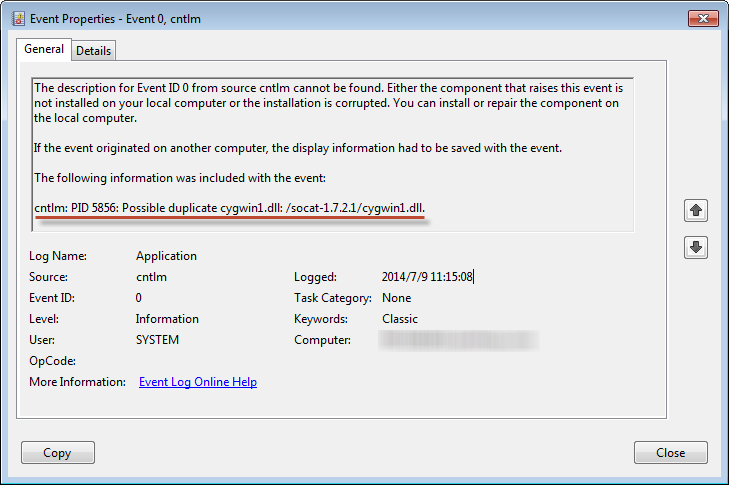配置
下载安装Cntlm之后。仅仅须要改动cntlm.ini文件,提供身份认证必要的信息,然后以服务的方式启动cntlm就能够了。
在cntlm.ini中有例如以下几个重要的配置是可能须要改动的:
Username - your domain/proxy account name
Domain - the actual domain name
Workstation - NetBIOS name of your workstation; Cntlm tries to autodetect it, but you might want to set it explicitly should dialect detection fail (see below)
Proxy - IP address (or ping-able hostname) of your proxy; if you use several alternative proxies or know of backup ones, use this option multiple times; if one stops working, Cntlm will move on to the next
Listen - local port number which Cntlm should bind to; the default is OK, but remember you can't have more than one application per port; you can use netstat to list used up ports (lines with LISTEN)
#
# Cntlm Authentication Proxy Configuration
#
# NOTE: all values are parsed literally, do NOT escape spaces,
# do not quote. Use 0600 perms if you use plaintext password.
#
Username laurence
Domain abc
Password 123
# NOTE: Use plaintext password only at your own risk
# Use hashes instead. You can use a "cntlm -M" and "cntlm -H"
# command sequence to get the right config for your environment.
# See cntlm man page
# Example secure config shown below.
# PassLM 1AD35398BE6565DDB5C4EF70C0593492
# PassNT 77B9081511704EE852F94227CF48A793
### Only for user 'testuser', domain 'corp-uk'
# PassNTLMv2 D5826E9C665C37C80B53397D5C07BBCB
# Specify the netbios hostname cntlm will send to the parent
# proxies. Normally the value is auto-guessed.
#
# Workstation netbios_hostname
# List of parent proxies to use. More proxies can be defined
# one per line in format <proxy_ip>:<proxy_port>
#
Proxy 192.168.0.1:80
# List addresses you do not want to pass to parent proxies
# * and ?wildcards can be used # NoProxy localhost, 127.0.0.*, 10.*, 192.168.* # Specify the port cntlm will listen on # You can bind cntlm to specific interface by specifying # the appropriate IP address also in format <local_ip>:<local_port> # Cntlm listens on 127.0.0.1:3128 by default # Listen 3128 # If you wish to use the SOCKS5 proxy feature as well, uncomment # the following option. It can be used several times # to have SOCKS5 on more than one port or on different network # interfaces (specify explicit source address for that). # # WARNING: The service accepts all requests, unless you use # SOCKS5User and make authentication mandatory. SOCKS5User # can be used repeatedly for a whole bunch of individual accounts. # #SOCKS5Proxy 8010 #SOCKS5User dave:password # Use -M first to detect the best NTLM settings for your proxy. # Default is to use the only secure hash, NTLMv2, but it is not # as available as the older stuff. # # This example is the most universal setup known to man, but it # uses the weakest hash ever. I won't have it's usage on my # conscience. :) Really, try -M first. # #Auth LM #Flags 0x06820000 # Enable to allow access from other computers # #Gateway yes # Useful in Gateway mode to allow/restrict certain IPs # Specifiy individual IPs or subnets one rule per line. # #Allow 127.0.0.1 #Deny 0/0 # GFI WebMonitor-handling plugin parameters, disabled by default # #ISAScannerSize 1024 #ISAScannerAgent Wget/ #ISAScannerAgent APT-HTTP/ #ISAScannerAgent Yum/ # Headers which should be replaced if present in the request # #Header User-Agent: Mozilla/4.0 (compatible; MSIE 5.5; Windows 98) # Tunnels mapping local port to a machine behind the proxy. # The format is <local_port>:<remote_host>:<remote_port> # #Tunnel 11443:remote.com:443
当中对于监听端口使用默认的端口3128就能够了。我们能够通过命令来验证配置是否正确:
cntlm -c /path/to/cntlm.ini -I -M http://www.baidu.com
假设能正常返回就表示各项配置都是正确的,接下就能够启动cntlm服务在后台执行了,使用命令:
net start cntlm
服务启动之后,我们就能够在第三方应用的代理配置上这样设定了:代理server:127.0.0.1 (即本机),代理server端口:3128(即cntlm.ini文件里配置的Listen端口)
日志与常见错误
cntlm绝大多数错误表现为服务无法启动。详细原因有非常多,好在cntlm有较好的日志信息能够帮助我们找到问题的根源,查看cntlm日志的方法是:Start -> Settings -> Control Panel -> Administrative Tools -> Event Viewer, 然后在左側面板的文件夹树中选择:Windows Logs -> Application, 再在右側面板中配置一下过虑项,将事件源设定为cntlm就能够过滤出全部的cntlm日志了。
这里我们介绍两种可能的错误:
1. cntlm: PID XXXX: Possible duplicate cygwin1.dll: /socat-1.7.2.1/cygwin1.dll.
相似这种错误是由于cygwin1.dll冲突引起的。有多种工具会携带自己的cygwin1.dll,假设版本号不兼容就会报如上的错误,最简单的方是先移除它们。
2. cntlm: Parent proxy address missing
这是一个easy造成误导的错误,假设多数情况下并非由于你在cntlm.ini中错误地制定了Proxy而是cntlm程序启动时根本没用找到cntlm.ini文件,造成这种问题的可能诱因之中的一个是在安装cntlm时改动了默认的安装文件夹,这应该是cntlm的一个bug。不知道在启动cntlm服务的配置界面(Control Panel -> Administrative Tools -> Services)上指定-c參数是否有效。有有兴趣的朋友可以试试,我按照默认配置重装cntlm已解决。
版权声明:本文博主原创文章,博客,未经同意不得转载。























 792
792

 被折叠的 条评论
为什么被折叠?
被折叠的 条评论
为什么被折叠?








